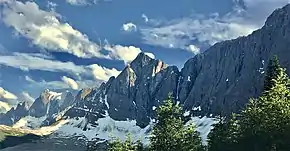| Mount Drysdale | |
|---|---|
 Mount Drysdale (left of center) with the Rockwall (right) as seen from Rockwall Pass | |
| Highest point | |
| Elevation | 2,932 m (9,619 ft)[1] |
| Prominence | 162 m (531 ft)[1] |
| Parent peak | Rockwall Peak (2979 m)[1] |
| Listing | Mountains of British Columbia |
| Coordinates | 51°09′00″N 116°16′22″W / 51.15000°N 116.27278°W[2] |
| Geography | |
 Mount Drysdale Location of Mount Drysdale in British Columbia  Mount Drysdale Mount Drysdale (Canada) | |
| Location | Kootenay National Park British Columbia, Canada |
| District | Kootenay Land District |
| Parent range | Vermilion Range Canadian Rockies |
| Topo map | NTS 82N1 Mount Goodsir[2] |
| Geology | |
| Age of rock | Cambrian[3] |
| Type of rock | Ottertail Limestone[3] |
| Climbing | |
| First ascent | John Peck, Dornacilla Peck, (Dornacilla Drysdale), and Dr. Morley Tuttle[1] |
Mount Drysdale is a 2,932-metre (9,619-foot) mountain summit located on the western border of Kootenay National Park in the Vermilion Range, which is a sub-range of the Canadian Rockies of British Columbia, Canada. Its nearest higher peak is Rockwall Peak, 1.0 km (0.62 mi) to the west.[1] The mountain is part of what is known as the Rockwall which is an escarpment of the Vermilion Range. The Rockwall Trail is a scenic 55 kilometre (34 mile) traverse of alpine passes, subalpine meadows, hanging glaciers, and limestone cliffs, in some places in excess of 900 m (2,950 ft) above the trail.[4]
History
_(20456297901).jpg.webp)
The mountain's name was officially adopted in 1924 by the Geographical Names Board of Canada to honor Charles Wales Drysdale (1885-1917), a member of the Geological Survey of Canada who drowned in the Kootenay River on July 10, 1917, along with his assistant William Gray when their raft capsized and both were swept away while working on a field survey.[2] [5] [6] Mount Drysdale and Mount Gray form the buttresses on either side of Wolverine Pass.
The first ascent of Mount Drysdale was made by John Peck, Dr. Morley Tuttle and Dornacilla Peck (Dornacilla Drysdale), who was Drysdale's eldest daughter.[1]
Geology

Mount Drysdale is composed of Ottertail limestone, a sedimentary rock laid down during the Precambrian to Jurassic periods and pushed east and over the top of younger rock during the Laramide orogeny.[7]
Climate
Based on the Köppen climate classification, Mount Drysdale is located in a subarctic climate zone with cold, snowy winters, and mild summers.[8] Temperatures can drop below −20 °C with wind chill factors below −30 °C. Precipitation runoff from the mountain drains east into tributaries of the Vermilion River, or west into tributaries of the Beaverfoot River.
References
- 1 2 3 4 5 6 "Mount Drysdale". Bivouac.com. Retrieved March 16, 2019.
- 1 2 3 "Mount Drysdale". Geographical Names Data Base. Natural Resources Canada. Retrieved March 16, 2019.
- 1 2 Baird, David M. (1964). "Kootenay National Park: Wild Mountains and Great Valleys" (PDF). parkscanadahistory.com. Geological Survey of Canada. Retrieved April 26, 2021.
- ↑ "Backpacking - Kootenay National Park". pc.gc.ca. Parks Canada. March 16, 2019. Retrieved March 13, 2019.
- ↑ "Mount Drysdale". cdnrockiesdatabases.ca. Retrieved April 26, 2021.
- ↑ "Mount Drysdale". BC Geographical Names. Retrieved April 26, 2021.
- ↑ Gadd, Ben (2008), Geology of the Rocky Mountains and Columbias
- ↑ Peel, M. C.; Finlayson, B. L.; McMahon, T. A. (2007). "Updated world map of the Köppen−Geiger climate classification". Hydrol. Earth Syst. Sci. 11: 1633–1644. ISSN 1027-5606.
External links
- Mount Drysdale weather forecast
- Parks Canada web site: Kootenay National Park